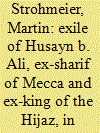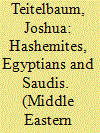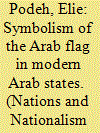|
|
|
Sort Order |
|
|
|
Items / Page
|
|
|
|
|
|
|
| Srl | Item |
| 1 |
ID:
166766


|
|
|
|
|
| Summary/Abstract |
This article deals with the exile of Husayn ibn Ali, ex-sharif of Mecca and ex-king of the Hijaz, in Cyprus (1925–1930). It was not politics, but the adversities of everyday life that shaped the ex-king’s stay in the British colony. Loss of prestige, estrangement, uncertainty about the future, lawsuits, financial problems and the death of his wife contributed to failing health which ultimately led to his relocation to Amman. A special, perhaps unique feature of Husayn’s enforced residence in the island is that the power which exiled him also granted him asylum. This article examines his living conditions, experience with and image in the local community, relations with his sons as well as his dealings with British authorities. In this way the progressive isolation and marginalization of an ex-monarch in exile becomes evident.
|
|
|
|
|
|
|
|
|
|
|
|
|
|
|
|
| 2 |
ID:
174141


|
|
|
|
|
| Summary/Abstract |
Most analyses of the fate of the Hijaz and the Muslim pilgrimage after the First World War have focused on the struggle between Hashemites and Saudis. But in actuality the Egyptians were heavily involved in this dispute, for the Hijaz had been for centuries part of a geopolitical system based on the Red Sea littoral states. Indeed, this was a tripartite struggle, which afforded much more room for maneuver than a simple bilateral one. This article covers the maneuvers of all three parties, demonstrating how they tried to gain possession of the hajj, and all that meant for world Islamic leadership.
|
|
|
|
|
|
|
|
|
|
|
|
|
|
|
|
| 3 |
ID:
104119


|
|
|
|
|
| Publication |
2011.
|
| Summary/Abstract |
The national flag, anthem and emblem are the three symbols through which an independent country proclaims its identity and sovereignty. Although each state has its distinctive flag, there are similarities in the flags of certain countries, such as in Scandinavia (the cross) and Africa (colours). These symbolise certain propinquity in terms of ideology, culture and history. Similarity is also to be found in the flags of the Arab countries: out of the twenty-two current members of the Arab League, ten share the same colours on their flags (green, white, black and red), while a certain Islamic symbol (eagle, star) in some flags represents the uniqueness of that country. Of the other twelve countries, most rely on one colour of the four (usually red or green) while nine use Islamic symbols (stars, crescent and sword) on their flags. In spite of the importance of this national symbol, the study of the modern Arab flag is almost non-existent. This article explores the modern evolution of the Arab flag and the reasons for the similarities in many Arab flags. In particular, it will deal with the pan-Arab flags of the Hashemites Kingdom of the Hijaz (1916-26), Jordan, Iraq, Palestine, Syria and Egypt.
|
|
|
|
|
|
|
|
|
|
|
|
|
|
|
|
|
|
|
|
|